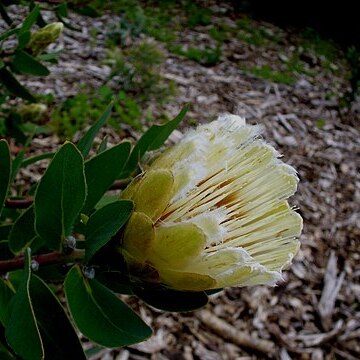Small upright tree, 3-8 m, occasionally up to 12 m in height, with a straight main trunk 150-250 mm in diam.; bark smooth, grey. Stems minutely puberulous initially, soon glabrous, 3-6 mm in diam. Leaves narrowly elliptic to elliptic or elliptic-lanceolate, acute, 60-120 mm long, 18-40 mm wide, very sparsely sericeous initially but soon quite glabrous, bright green in fresh state. Inflorescences oblong-obconic, 65-80 mm long, 40-65 mm wide. Involucral receptacle 10-15 mm in diam., flat to very slightly convex. Involucral bracts 5-6 seriate, outer surface sparsely sericeous with glabrescent patches, to very densely sericeous; outer series broadly ovate acute, 8-10 mm long, 10-12 mm wide; inner series broadly oblong to oblong, the innermost series occasionally oblong-spathulate, 35-40 mm long, 8-15 mm wide, imbricate, apices rounded with white to slightly tawny, silky beards. Perianth 50-70 mm long, straight; tube 12-15 mm long, glabrous proximally but tawny-villous distally; claws filiform, tawny villous to pilose on inner and outer surface; limbs straight, linear-acute, glabrous but apices prominently crinite with wavy whitish-tawny, silky trichomes. Anthers 4, linear, subsessile. Style 55-65 mm long, straight, glabrous, sub-terete. Pollen presenter linear-filiform 8-10 mm long, apex very prominently capitate, drying black. Ovary obconic, 2 mm long, covered with 8-10 mm long, tawny trichomes. Hypogynous scales 1.5 mm long, lanceolate-acute. Flowering commences in January, reaching a peak in February, March and April, but may continue sporadically until September.
More
Large shrub or small tree, erect, single trunk, 3-8 m high. Leaves elliptic to elliptic-lanceolate, 60-120 x 18-40 mm, acute, sparsely hairy, glabrous when mature. Flower head oblong-obconic, 60-80 x 40-65 mm. Involucral bracts 5-or 6-seriate, greenish cream-coloured or pink, densely covered with silky hairs, tips with white to tawny silky fringes; outer series ovate, acute, 8-10 x 10-12 mm; inner series oblong, rounded, 35-40 x 8-15 mm, imbricate. Flowers 50-70 mm long, straight, tube 12-15 mm long, glabrous, tips wavy with silky white-tawny hairs; style 55-65 mm long, straight; pollen presenter 8-10 mm long, thread-like, tip a large knob. Flowering time Feb.-Apr.
Shrub or tree to 8(-12) m. Leaves oblanceolate, glabrescent. Flower heads oblong-obconic, 65-80 x 40-65 mm, involucral bracts white to pink, silky, fringed, style 55-65 mm long.


